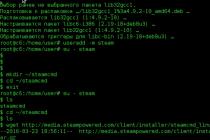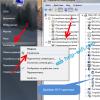Depending on the number of EMF (power) sources in the circuit, its topology and other features, the circuit is analyzed and calculated by various methods. In this case, the EMF (voltage) of the sources of electricity and the parameters of the circuit are usually known, the calculated ones are the voltage, currents and powers.
In this chapter, we will get acquainted with the methods of analysis and calculation of DC circuits of varying complexity.
Calculation of circuits with one power supply
When there is one active element in the circuit (source of electricity), and the others are passive, for example resistors /? t, R 2, ..., then the chains are analyzed and calculated schema conversion method, the essence of which is the transformation (convolution) of the original circuit into an equivalent one and subsequent unfolding, in the process of which the sought values are determined. We will illustrate this method for calculating circuits with series, parallel and mixed connection of resistors.
A circuit with series connection of resistors. Let's consider this issue with the following qualitative example. From an idealized EMF source E (R 0 = 0), at the output terminals of which there is a voltage U, those. when E = U, through series-connected resistances R (, R 2 ,..., R n the load (receiver) is powered with a resistance R H(fig. 2.1, a).
Rice. 2.1
It is required to find the voltage, resistance and power of the equivalent circuit shown in Fig. 2.1, b, making the appropriate conclusions and generalizations.
Solution
A. With known resistances and current, the voltages on individual elements of the circuit, according to Ohm's law, would be as follows:
B. The total voltage (EMF) of the circuit, according to the second Kirchhoff's law, will be written as follows:


D. Multiplying all terms (2-2) by current / or (2-5) by R, will have where
B. Dividing all the terms (2-2) by the current /, we obtain where

Formulas (2-3), (2-5), (2-7) show that in a circuit with one power supply and a series connection of resistances, the equivalent voltage, resistance and power are equal to the arithmetic sums of voltages, resistances and powers of the circuit elements.
The above ratios and conclusions indicate that the original circuit in Fig. 2.1, a with resistances /? 2, R „ can be replaced (collapsed) with the simplest one in Fig. 2.1, b with equivalent resistance R 3, defined by expression (2-5).
a) for the circuit in Fig. 2.1, b, the following relations hold: U 3 = U = RI, where R = R 3 + R u. Eliminating the current / from them, we obtain the expression
which shows that the voltage U 3 on one of the resistances of a circuit consisting of two connected in series is equal to the product of the total voltage U on the resistance ratio of this section R 3 to the total resistance of the circuit R. Based on this
b) current and voltage in the value of fig. 2.2, b can be written in different versions:
Solved tasks
Task 2.1. What are the resistance, voltage and power of the circuit in Fig. 2.1, but if I= 1 A, R x= 1 Ohm, D 2 = 2 Ohm, = 3 Ohm, R u= 4 ohms?
Solution
The voltages across the resistors will obviously be equal: U t = IR ^= 1 1 = 1 V, U 2
= IR2
=
= 1 2 = 2 V, U n= / L i = 1 3 = 3 V, t / H = ZR H = 1 4 = 4 V. Equivalent circuit resistance: R 3
= R ( + /? 9 + R n = 1 + 2 + 3 = 6 ohms. Resistance, voltage and power of the circuit: /? = &, + /? „= 6 + 4 = 10 Ohm; U = U (+ U 2 + U „+ U n = 1 + 2 + 3 + 4 = 10 V, or U = IR == 1 10 = 10 V; P = W = 10 - 1 = 10 W, or P =UJ + U 2 I + U n I + U U I = 11 + 21 + 31 + + 4 1 = 10 W, or P = PR X + PR 2
+ PR a + PR n = 12 1 + 12 2 + 12 3 + 12 4 = 10 W, or P = U / R x + U? 2
/ R 2 + UZ / R n +1/2 /R n = 12/1 + 22/2 + 32/3 + 42/4 = 10 W.
Task 2.2. In the circuit according to fig. 2.1, and known: U = MO B, R (= Ohm, R 2
= 2 Ohm, = = 3 Ohm, R H = 4 ohms. Define U 2.
Solution
R =/ ?! + / ?, + L 3 + L 4 = L, + L H = 1+2
+ 3 + 4 = 6 + 4 = 10
Ohm, 1 = 11 / R = 110/10
= = 11 A, // 2 = L? 2 = 11 2 = 22 V orU 2 = UR 2 / R =110 2/10 = 22 V.
Tasks to be solved
Task 2.3. In the circuit according to fig. 2.1, a known: U = MO B, R ^ = Ohm, R 2
= 2 Ohm, R n= = 3 Ohm, R u= 4 ohms. Determine P „.
Task 2.4. In the circuit according to fig. 2.1, b are known: U = 110 V, U H= 100 V, = 2 ohms. Determine R e.
Task 2.5. In the circuit according to fig. 2.1,6 known: U = 110 V, R t= 3 Ohm, D n = 2 Ohm. Define =
[q]/[t] = Cl / c = A × c / c = A (ampere).
Constant electric current(further current) Is a constant and unidirectional movement of charged particles (charges). At constant current during each equal period of time D t the same charge D is transferred q... Therefore, the current where q - the whole charge (C) for the time t(With) .
Conditional positive direction of current I in the external (from the energy source) circuit opposite to the direction of motion of the flow of electrons (an electron is a particle with the least negative charge ( q e= -1.602 × 10 - 19 C, then 1 C = 6.24 × 10 18 electrons), i.e. it flows from the point a with great potential to the point b with less potential, causing voltage drop(further voltage) on the resistance of this section
U ab= j a- j b. (1.2)
E electrical voltage
Is the work spent on transferring a unit of charge (1 C) from a point a exactly b electric field along an arbitrary path. Only potential difference
(stress) between the corresponding points. When they talk about the potential of a point in an electrical circuit, they mean the potential difference between this point and another (usually grounded), the potential of which is taken to be zero.
Electromotive forceE(hereinafter EMF E in volts) of the energy source is numerically equal to the work (energy) W in joules (J) spent by external and induced electric fields to move a unit of charge (1 C) from one point of the field to another.
A1.2. Electrical circuit composition. Any electrical circuit consists of the following elements:
· energy sources(active elements) that convert various types of energy into electrical energy. These are generators of power plants, storage and solar batteries, thermocouples, etc .;
· receivers
electrical energy (passive elements), in which electrical energy is converted into other types: thermal (heating elements), mechanical (electric motors), light (fluorescent lamps), chemical (galvanic baths), etc.;
· auxiliary elements
(wires, switches, fuses, resistive current regulators, measuring instruments, connectors, etc.).
It is customary to depict electrical circuits in the form of electrical circuits: schematic, wiring, equivalent circuits, etc. Electrical circuit diagram
- this is its graphic representation, containing the symbols of circuit elements and showing the connections of these elements.
When analyzing electrical circuits, they are replaced by equivalent circuits. Equivalent circuit
an electrical circuit is its calculation and mathematical model, containing ideal passive (resistive, inductive and capacitive) and active (voltage sources and current sources) elements. Element
An electrical circuit is a separate device that performs a certain function in a circuit.These elements are equivalents (models) of real circuit devices, which are theoretically attributed to certain electrical and magnetic properties, reflecting the main (dominant) processes in the circuit elements.
Passive elements of an electrical circuit are called that are not capable of generating electrical energy. Passive elements include resistors, inductive coils and capacitors (Table A1.1).
Resistor Is a passive element of an electrical circuit designed to use its electrical resistance R... The resistor cannot accumulate energy: the electrical energy received by it is irreversibly converted into thermal energy in it.
Table A1.1. Passive circuit elements and their characteristics
Inductive coil
Is a passive circuit element designed to use its own inductance L and / or its magnetic field. With an increase in the current in the inductive coil, electrical energy is converted into magnetic energy and its accumulation in the magnetic field of the coil, and with a decrease in the current, the reverse transformation of the magnetic field energy into electrical energy returned to the source occurs.
Capacitor Is a passive circuit element designed to use its electrical capacity WITH... When the voltage at the terminals of the capacitor rises, the electrical energy of the external source is converted into the energy of the electric field due to the accumulation of charges of opposite signs on its two electrodes (plates). When the voltage decreases, the reverse transformation of the electric field energy into electrical energy, which is returned to the source, occurs.
Active elements -
these are sources of electrical energy (batteries, generators, etc.). Distinguish between: voltage sources (IN) and current sources (IT), depending on their internal resistance (Table A1.2). V voltage source internal resistance R watt significantly less resistance R load (in ideal ID R w = 0), and at current source R watt significantly more resistance R load (in ideal IT R W = ¥), and conductivity (in siemens)
G w = 1 / R tue<< G = 1/R.
Table A1.2. Active circuit elements and their characteristics
V, |
| Current source (IT) | A1.3. Topological parameters of circuit diagrams... When analyzing electrical circuits, use the following topological parameters of the schemes:
· branch
(V) - a section of an electric circuit along which the same electric current flows;
· knot
(Have) - the junction of the branches of the electrical circuit. Usually the place where two branches are connected is not called a node, but connection(or a removable knot), and the knot connects at least three branches;
· circuit
- a sequence of branches of an electric circuit, forming a closed path, in which one of the nodes is simultaneously the beginning and end of the path, and the rest occur only once. Linear independent circuits are distinguished in the electrical circuit. k n, which differ from each other by at least one branch. The number of independent contours depends on the number of branches V and the number of nodes Have in the chain:
k n = B – (Have – 1). (1.3)
So, in the circuit diagram (Fig. A1.1) branches B = 5, knots Y = 3, connections 2, independent circuits k n =
3.
Notes.
1. Points 5
, 6
, 7
and 8
have the same electrical potential, so they can be geometrically combined into one common point - knot.
2. Points 1
and 4
connect two elements, so they are called connection points of two elements rather than knots.
A1.4. Chain design problem... Calculation of an electrical circuit consists in describing its equivalent circuit with mathematical equations and in solving a system of equations for electrical quantities. The theory of electrical and magnetic circuits is based on the introduction of the parameters of individual sections of the circuit, of which the main ones are resistance, inductance and capacity. In addition to these parameters, many others are introduced into consideration (for example, the magnetic resistance of the magnetic circuit, the reactance and conductivity of the alternating current circuit, etc.), which are in a known connection with them or have independent significance. The task the calculation of the electrical circuit is, first of all, the determination of the currents and voltages of the branches at the given values of the parameters of the active and passive elements of the circuit circuit.
Several methods have been developed for calculating electrical circuits (more precisely, their equivalent circuits), the most common of which are the method of direct application of Kirchhoff's laws, the method of nodal voltages, the method of state variables, and the method of loop currents.
Note: The terms "electrical circuit" and "circuit diagram" are often confused.
A1.5. Ohm's and Kirchhoff's laws. Solving the problems of analyzing electromagnetic processes in a well-known electrical circuit with given parameters of energy sources and resistive elements is based on the application of Ohm's law, the first and second Kirchhoff laws, which are written, respectively, for branches, knots and contours(Table A1.3).
Ohm's law sets the relationship between current and voltage at passive branch when the directions of the current and voltage on it coincide. (see Table A1.3, second line). For a branch with voltage sources use generalized Ohm's law: (see Table A1.3, third line). Plus sign in front of EMF E and tension U 12 are recorded when their directions coincide with the conditionally positive direction of the current I and a minus sign - if their directions do not coincide with the direction of the current.
Kirchhoff's first law(1ZK) write for knots electrical circuit (see table. A1.3, fourth line). The law is formulated as follows: the algebraic sum of currents in any node of the circuit diagram is equal to zero. In this case, currents directed to the node are usually written with a plus sign, and those leaving the node, with a minus sign.
Kirchhoff's second law(2ZK) applies to contours electrical circuit (see Table A1.3, fifth line) and is formulated as follows: in any circuit of the circuit, the algebraic sum of the EMF is equal to the algebraic sum of voltages in all sections with resistances included in this circuit. In this case, the EMF and voltages on the circuit elements are recorded with a plus sign if the chosen direction of bypassing the circuit (for example, clockwise) coincides with the direction of the voltages (currents) on these elements, and with a minus sign if they do not match.
Table A1.3. Topological parameters of circuit diagrams and their description
| Kirchhoff's first law (1ZK) |
å I k = 0,
I 1 - J-I 2 -I 3 = 0
|
| Circuit | | Kirchhoff's second law (2ZK) |
å E k = å U k,
E 2 - E 3 = R 1 I 1 +
+R 2 I 2 -R 3 I 3 -U 12
|
A1.6. Calculation method based on Kirchhoff's laws... Analysis and calculation of any direct current electric circuit can be carried out as a result of the joint solution of the system of equations composed by means of the first and second Kirchhoff laws. The number of equations in the system is equal to the number of branches in the chain ( N MZK = V), while the number of independent equations that can be written according to 1ZK is one equation less than the number of nodes, i.e.
N 1ZK = Have - 1, (1.4)
and the number of independent equations written according to 2ZK,
N 2ZK = B - (Have - 1), (1.5)
where V- the number of branches with unknown currents (without branches with current sources); Have is the number of nodes.
Let us compose, using Kirchhoff's laws, the required number of equations to determine the currents of the branches of the circuit (Fig. A1.2), if the EMF is given E 1 and E 2 voltage sources, current J source of current and resistance R 1 ,…, R 5 resistors.
N MZK = N 1ZK + N 2ZK = V.
To this end:
1. Let's carry out a topological analysis of the circuit to determine the number of independent equations. In the scheme B 1 = 6 branches, Have= 3 nodes. However, in the branch with IT, the current J is given, so the number of independent branches V= 5. The number of independent equations for solving the problem by the method of Kirchhoff's laws
N MZK = B = 5.

![]()
3. Let's compose the equations for 1ZK (
N 1ZK =
Have - 1 = 3 - 1 = 2):
for node 1
: I 1 - I 2 - J - I 3 = 0, (1)
for node 2
: I 3 - I 4 + I 5 = 0. (2)
4. Select independent contours and the direction of traversing the contours, for example, clockwise. In our case, there are three independent circuits, since the branch with a given current J IT in the equations compiled by 2ZK is not taken into account:
N 2ZK = B - (Have - 1) = 5 – (3 – 1) = 3.
5. Let's compose three equations for 2ZK:
for contour 1"-1-0-1"
: E 1 = R 1 I 1 + R 2 I 2 , (3)
for contour 1-2-0-1
: 0 = R 3 I 3 + R 4 I 4 - R 2 I 2 , (4)
for contour 2-2"-0-2
: -E 2 = -R 5 I 5 -R 4 I 4 . (5)
6. Having solved the system of equations (1) ... (5), for example, by the Gauss method or using Cramer's formulas, it is possible to determine all the unknown currents of the circuit branches.
A1.6. Structural transformations of circuit equivalent circuits. The calculation of electrical circuits can be simplified by converting their equivalent circuits into simpler and more convenient for calculation. Such transformations lead, as a rule, to a decrease in the number of circuit nodes and, consequently, in the required number of initial equations for the calculation.
So, branch with consistently connected resistors R 1 , R 2 , … , R n can be converted into a simple circuit with one resistive element (Fig.A1.4 a), the equivalent resistance of which is equal to the sum of the resistances:
and a branch with several series-connected voltage sources and resistors (Fig. A1.4 b) can also be transformed into a branch with one equivalent ID with parameters R uh and E e (Fig.P1.4 v):
Parallel connected resistors with resistances
R 1 ,
R 2 ,…,
R n(Fig. A1.5
a) can be replaced with one resistor with conductivity
G e (Fig.P1.5
b).
Since the voltage on all branches is the same, equal U, then the currents of the branches
where, are the branch conductivities in siemens.
In a two-node circuit 1
and 2
(see fig.A1.5 a) current at the circuit input
a equivalent conductivity
and equivalent resistance
passive section of the chain between nodes 1
and 2
are equal
Electrical circuits having a combination of serial and parallel connections of circuit sections (
mixed compound), can be converted into simpler equivalent circuits by replacing parallel branches with one branch, and series-connected sections of the circuit with one section. So, for example, for the circuit in Fig. A1.6
a first you need to find the equivalent resistance of the parallel section
2
-
3
with three resistors connected in parallel
and then fold it down with resistance R 1 (Fig.A1.6 b, v):
In electrical circuits, elements can be connected according to the scheme triangle or according to the scheme star(Fig. A1.7). Triangle call the connection of three elements, in which the end of the first element is connected to the beginning of the second, the end of the second to the beginning of the third, and the end of the third to the beginning of the first (Fig. A1.7 a). Star called a connection in which the ends of three elements are connected to one common point P(Fig. A1.7 b).
In order to multiply the number of nodes in the circuit diagram, the connections of the elements with a triangle are converted into an equivalent star connection using the following formulas:
,
, (1.10)
that is, the resistance of the ray of an equivalent star is equal to a fraction, in the numerator of which is the product of two resistances of the sides of the triangle adjacent to the node under consideration, divided by the sum of all resistances of the sides of the triangle.
A1.7. Voltage divider rule. In a branch consisting of two series-connected resistors (Fig.P1.8 a), the voltage across one of the resistors is equal to the voltage applied to the branch multiplied by the resistance of this resistor and divided by the sum of the resistances of both resistors ,
i.e.
and (1.11)
A1.8. Current divider rule... For a circuit with two parallel-connected resistors (Fig. A1.8 b) the current of one of the two parallel branches of the circuit is equal to the current suitable for the branching I multiplied by the resistance of the other (opposite) branch and divided by the sum of the resistances of both branches, i.e.
A1.9. Nodal stress method. The nodal stress method (EMC) is based on the first Kirchhoff's law and the generalized Ohm's law. In it, the so-called nodal voltages U k 0 - voltages between each k-th node of the circuit and the selected basic node (we will denote it by the number 0
), the potential of which is taken to be zero. The number of equations for calculating the scheme according to EOR
N MUN = Have - 1. (1.13)
For each node, except for the basic one, an equation is made according to 1ZK. In the equations obtained, the currents of the branches connected to the base node are expressed in terms of the nodal voltages and conductances by means of the generalized Ohm's law:
where G k = 1/R k- conductivity k th branch.
Current in the branch connected to the nodes k and j,
= (E kj - U k 0 + U j 0)G kj, (1.15)
where U kj = U k 0 - U j 0 – inter-nodal voltage; G kj = 1/ R kj - inter-node conductivity.
After grouping the members at the appropriate nodal stresses and transfer E k G k and currents J k current sources to the right, a system of equations for unknown nodal voltages is obtained.
The structure of each equation is the same, for example, an equation with respect to a node 1
:
G 11 U 10 -G 12 U 20 - ...
-G 1n U n 0 = + (1.16)
where G 11 = G 1 + G 2 + ... + G n - intrinsic conductivity of the node1 equal to the sum of the conductances of the branches connected to the node 1
(the conductances of the branches with IT are not taken into account, since G j = 1/R j= 0 (R j = ¥)); G 12 , ... , G 1 n- inter-node conductivity; + - nodal current knot 1
; - the algebraic sum of the products of the EMF of the branches connected to the node 1
, on the conductivity of these branches, and with the plus (minus) sign, the products are written if the EMF is directed to the node 1
(from node 1
); - the algebraic sum of the currents of the current sources of the branches connected to the node 1
, and currents J k written with a plus (minus) sign if they are directed to the node 1
(from node 1
).
Having solved the system of equations for the nodal voltages, the inter-nodal voltages and currents of the branches are determined by means of relations (1.14) and (1.15).
![]()
![]()
![]()
![]()
![]()
![]()
![]()
![]()
![]()
![]()
![]()
![]()
![]()
![]()
![]()
![]()
![]()
![]()
![]() Example A1.1.
Example A1.1. Using the method of nodal voltages, determine the currents of the branches of the circuit (Fig. A1.10), if
E 1
=
12V
, E 5
=
15V,
J = 2A,
R 1
=
1 Ohm,
R 2
=
5 Ohm,
R 3
= = R 4
=
10Ohm,
R 5
=
1 ohm
.
The scheme has 6 branches and 3 nodes.
Solution. 1. Choose the base node 0
and directions of nodal stresses U 10 and U 20 from knots 1
and 2
to the basic one (see Fig. A1.9).
2. We compose ( N MUN = Have- 1 = 3 - 1 = 2) EOR equations:
for node 1
: G 11 U 10 -G 12 U 20 = E 1 G 1 - J,
for node 2
: -G 21 U 10 + G 22 U 20 = E 5 G 5 ,
where G 11 = G 1 + G 2 + G 3 , G 12 = G 3 = 1/R 3 , G 22 = G 3 + G 4 + G 5 , G 21 = G 12 = G 3 .
3. After substitution of numeric values ( G 1 = 1/R 1 = 1 cm, G 2 = 0.2 cm, G 3 = G 4 = = 0.1 cm, G 5 = 1 cm) we have:
1,3U 10 - 0,1U 20 = 12 - 2 = 10,
0,1U 10 + 1,2U 20 = 15.
4. Using Cramer's formulas, we find the nodal stresses:
Note. The calculation of the nodal stresses must be carried out with great accuracy. In this example, it is sufficient to round the fourth decimal place.
5. Inter-node voltage
U 12 = U 10 - U 20 = 8.7097 - 13.226 = - 4.5163 B.
6. The sought currents of the branches (see the selected directions of the currents of the branches in Fig. A1.9):
I 1 = (E 1 - U 10)G 1 = 3.29 A, I 2 = U 10 G 2 = 1.754 A,
I 3 = U 12 G 3 = - 0.452 A, I 4 = U 20 G 4 = 1.323 A,
I 5 = (-E 5 + U 20)G 5 = -1.774 A.
7. Let's check the results of the calculation of currents. According to 1ZK for the node 2
:
= I 3 - I 4 - I 5 = - 0,452 - 1,323 + 1,774 = 0.
A1.10. Two-knot method... The two-node method is a special case of the nodal voltage method and is used to calculate circuits containing (after transformation) two nodes and an arbitrary number of parallel passive and active branches. To calculate the currents of the branches of the circuit, they make up and decide one thing the equation of the nodal voltage, equal to the algebraic sum of the currents created by all voltage sources and current sources of the circuit, divided by the node's own conductivity, i.e.
and the branch currents are determined by the generalized Ohm's law (see (1.14)).
Example A1.2. Simplify the circuit diagram (Fig. A1.10 a) by transforming the passive triangle into an equivalent star and find the currents in the converted circuit using two nodes. Find the currents of the branches of the passive triangle of the original circuit from the equations 1ZK for the nodes of the triangle and (if necessary) the equation 2ZK for the circuit, which includes one of the branches of the triangle with the desired current. Circuit equivalent circuit parameters: E 5 = 20V, E 6 = 36V; R 1 = 10 Ohm, R 2 = 12 Ohm, R 3 = 4 Ohm, R 4 = 8 Ohm, R 5 = 6 Ohm, R 6 = 5 ohms.
Solution. 1. Let's designate the nodes and dashed lines for the rays (branches) of the equivalent star R 1 n, R 2 n, R 3 n(Fig.A1.10 b) equal (see (1.10))
2. As a result of the transformations, we got a circuit with two nodes: n and 4 (Fig. A1.11), in which the nodes of the original circuit 1
, 2
and 3
became compounds.
3. The calculation of the circuit (Fig. A1.11) by the two-node method will be carried out in three stages:
a) choose the base node 4
and equate its potential to zero (j 4 = 0);

![]()
| a) b) Rice. A1.10. Calculated circuit diagrams |
b) direct the nodal voltage
U n 4 from node
n to node 4 and find its value (see (A1.11):



















